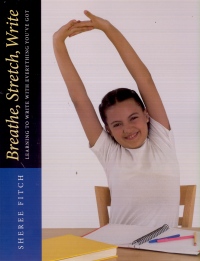| ________________
CM . . .
. Volume XVII Number 32. . . .April 22, 2011 
 |
Breathe, Stretch, Write: Learning to Write With Everything You've Got.
Sheree Fitch.
Markham, ON: Pembroke, 2011.
110 pp., pbk., $24.95.
ISBN 978-1-55138-256-2.
Subject Headings:
Creative writing (Elementary education).
Creative ability in children.
Breathing exercises.
Stretching exercises.
Hatha yoga.
Professional.
Review by Jocelyn A. Dimm.
**** /4
|
| |
|

excerpt:
This book is an invitation to approach the creative-writing process intentionally through the body, a whole-being approach to inspire the inner writer in every one of us. Writing is a process of discovery, and, by bringing our whole being to the work, we can make writing a safe, exciting, joyfully challenging experience for even the most reluctant writer. This book is based on personal, experiential truths:
• Working with breath and body grounds and focuses the mind.
• Writing is a physical exercise as well as a mentally challenging and intellectually demanding activity.
Fitch begins this writing manual by reminding readers that her book is about common sense. She talks about teachers being "permissionaries," explaining this person is "someone who gives you permission to dream your wildest dream, follow your heart, use your head, and share whatever gifts you've got" (p. 6). Fitch comments that common sense tells us that learning is a whole body experience, so why not pay attention to how breathing and stretching energize creativity, and here, the creative focus is on writing.
Fitch refers to a four element approach to the writing process she uses in all of her writing workshops: W.I.S.E., an acronym that refers to words, imagination, senses, and experience that are applied 'in the moment,' that is, allowing young writers to begin where they are at in their own lives, exploring rather than writing for an assignment or grade. In this way, Fitch says, this gentle approach stresses:
• Use of concrete and specific language over general
• That showing and telling are both important
• How metaphors are both powerful and individual
• That we are all original
• That we have tools, strategies, boundaries
• That keeping the pen moving will lead you somewhere
• That play does not mean "silly"
• That we are writers when we write
Fitch makes a point of outlining an easy-to-use framework of movement activities to develop writing throughout the chapters of this book. She begins by providing an overview in Chapter 1, of how to use the book, followed by subsequent chapters on The Standing Exercises (Chapter 2), The Sitting Exercises (Chapter 3), The Reclining Exercises (Chapter 4), The Moving Exercises (Chapter 5), and Group Moves (Chapter 6). (The chapters are only indicated by bold titles and not by actual numbers).
Along with short exercises to engage students, Fitch provides simple stick person images, often depicting a yoga position, and many anecdotal stories illustrating the actual exercises completed with students and teacher groups in workshops at schools, seminars, and conferences. The stories provide appealing examples of how the activities were carried out and what the participants thought of the exercises they were involved in combining some unique ways of breathing, stretching, and writing. For example,
FOOD FOR SOUL
• Pick a food. Begin writing about it. Or recipe. (Recipe/index cards can be used.)
• As you write, write in people you connect with this food.
I was teaching in a program at Arctic college called Dream Catchers. A student who had been quiet all week did the food exercise and shared. She wrote of her mother giving instructions for making bannock as she was dying of cancer. It was one of the most moving pieces I have ever read. Class stopped and, because our class had a kitchen and I had never tasted bannock, several of the women rustled around and found what they needed. In no time we were eating the bannock. We ate and talked about mothers and traditions, about sharing and love. About life and death. (p. 55)
Fitch's manual is designed to pull out activities that appeal to an educator and connect them to whatever is going on in the classroom at the moment. Although Breathe, Stretch, Write is designed with elementary school educators in mind, the strategies in this text can be used at all levels with minor adaptations.
There is also a short suggested reading list included just before the index providing other valuable writing resources.
Highly Recommended.
Jocelyn A. Dimm is a sessional instructor and doctoral student at the University of Victoria where she teaches drama education and young adult literature in the Faculty of Education.

To comment
on this title or this review, send mail to cm@umanitoba.ca.
Copyright © the Manitoba Library Association. Reproduction for personal
use is permitted only if this copyright notice is maintained. Any
other reproduction is prohibited without permission.
NEXT REVIEW |
TABLE OF CONTENTS FOR THIS ISSUE
- April 22, 2011.
AUTHORS |
TITLES |
MEDIA REVIEWS |
PROFILES |
BACK ISSUES |
SEARCH |
CMARCHIVE |
HOME |
